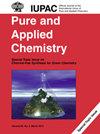Efficiency of green synthesised carbon nanotubes from Moringa oleifera leaf extract as potential toxic metals adsorbent in polluted water
IF 2
4区 化学
Q3 CHEMISTRY, MULTIDISCIPLINARY
引用次数: 0
Abstract
Among the many drawbacks of the current wastewater treatment systems are their high energy consumption and creation of harmful sludge. Carbon nanotubes (CNTs) are advantageous for the treatment of water due to their strong adsorption capacity and selectivity towards various pollutants. Thus, creating methods for treating water by producing CNTs from从油辣木叶提取物中提取的绿色合成碳纳米管作为潜在有毒金属吸附剂在污染水体中的效率
目前的废水处理系统有许多缺点,其中包括能耗高和产生有害污泥。碳纳米管(CNT)具有强大的吸附能力和对各种污染物的选择性,因此在水处理方面具有优势。因此,通过利用辣木叶提取物生产碳纳米管来创造水处理方法,对解决清洁水问题大有帮助。合成材料的超可见光(260-385 nm)、傅立叶变换红外光谱(764-3295 cm-1)和扫描电子显微镜(SEM)特性均证明了其 CNTs 特性。重复性测试得出了 Ca = 0.4、Cu = 0.24、Mg = 0.9、Pb = 1.06 和 Zn = 0.36 的 %RSD 值,表明 AES 方法具有很高的精确度。研究结果表明,金属回收量随保留时间的延长而增加。在 3、6、24 和 48 小时的保留时间内,镁、铜、锌、钙、铅的金属吸附能力依次增加。随着研究成分的初始浓度增加一倍和两倍,CNT 的去除能力也随之增加,这可能是溶液中金属离子增加的结果。这些结果表明了合成 CNT 清除废水中重金属的能力。
本文章由计算机程序翻译,如有差异,请以英文原文为准。
求助全文
约1分钟内获得全文
求助全文
来源期刊

Pure and Applied Chemistry
化学-化学综合
CiteScore
4.00
自引率
0.00%
发文量
60
审稿时长
3-8 weeks
期刊介绍:
Pure and Applied Chemistry is the official monthly Journal of IUPAC, with responsibility for publishing works arising from those international scientific events and projects that are sponsored and undertaken by the Union. The policy is to publish highly topical and credible works at the forefront of all aspects of pure and applied chemistry, and the attendant goal is to promote widespread acceptance of the Journal as an authoritative and indispensable holding in academic and institutional libraries.
 求助内容:
求助内容: 应助结果提醒方式:
应助结果提醒方式:


